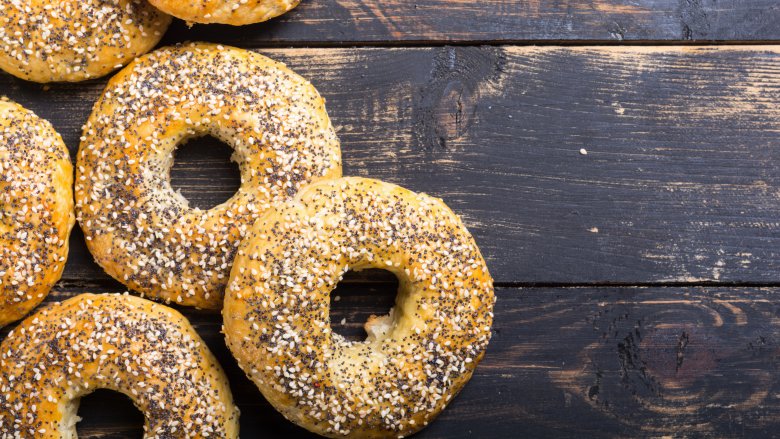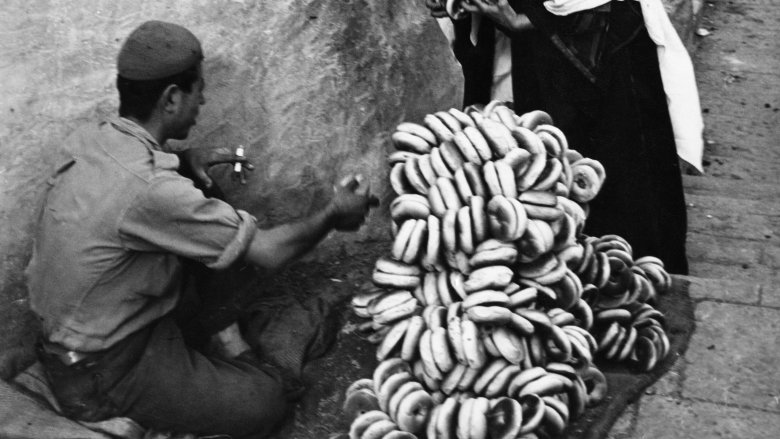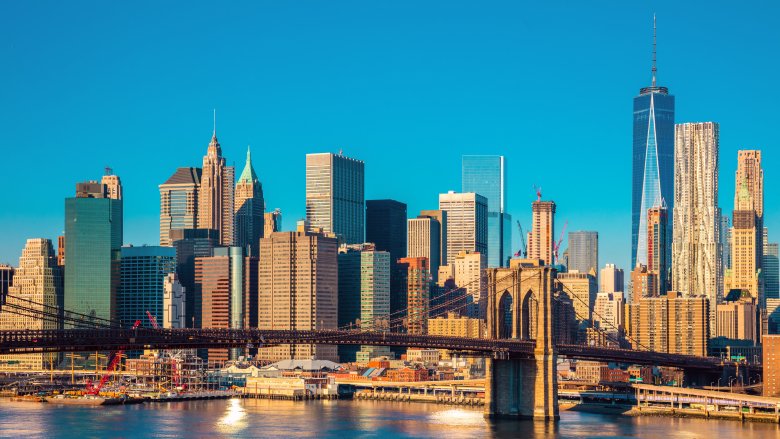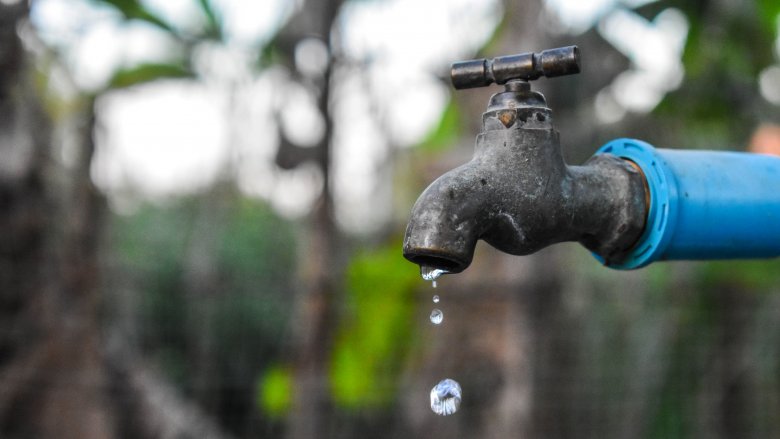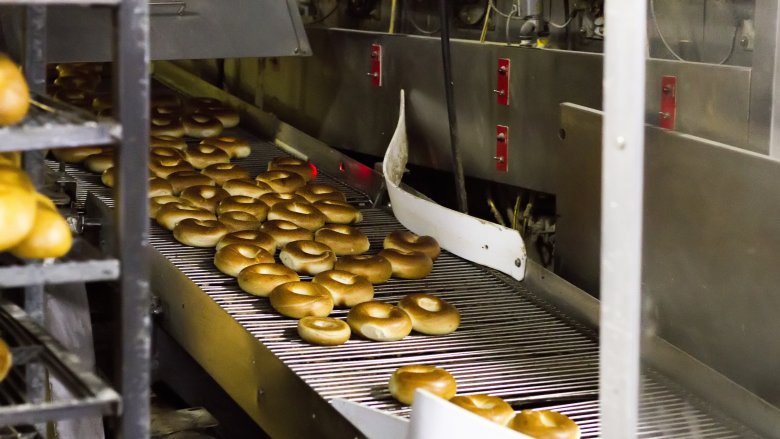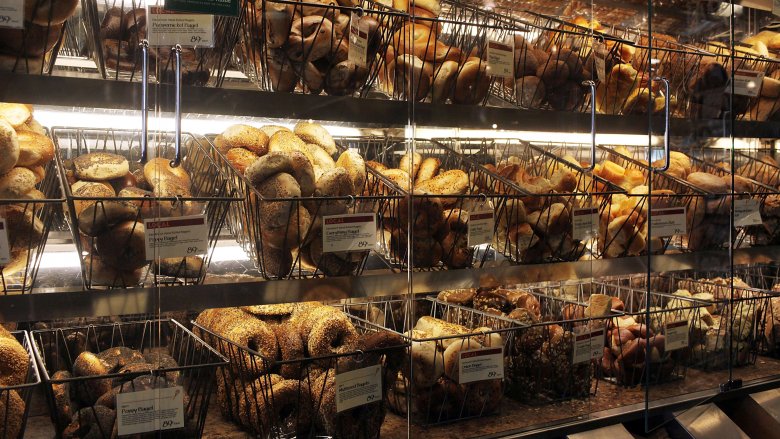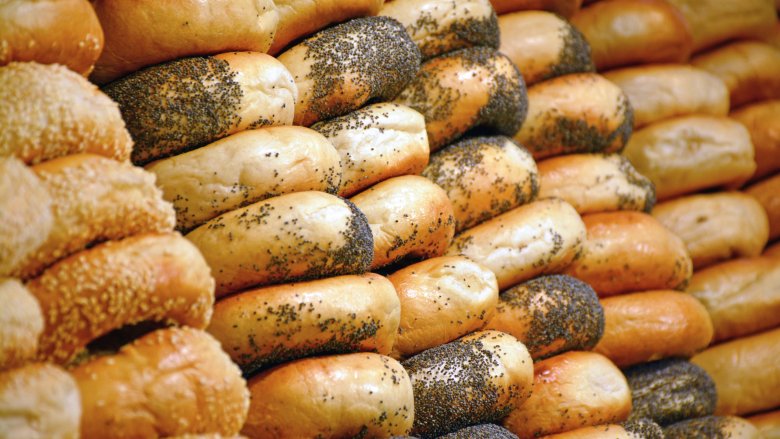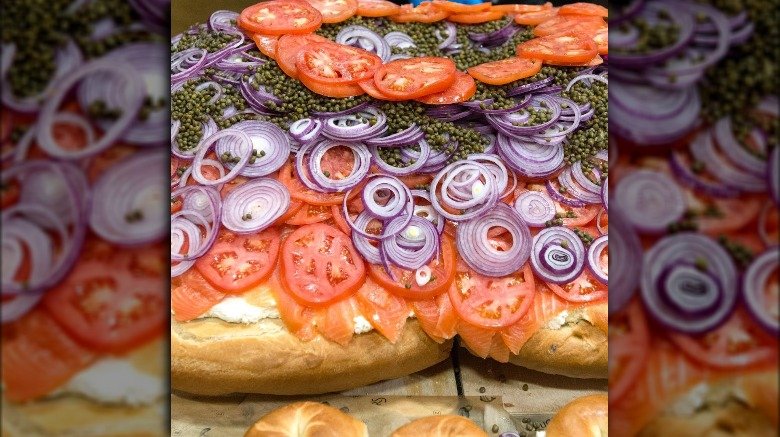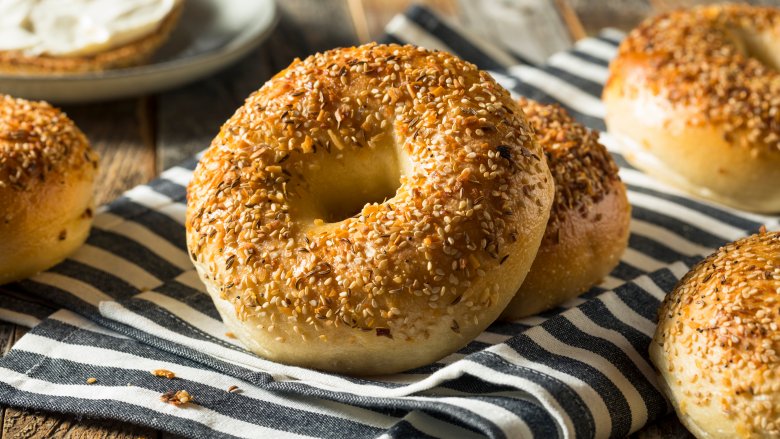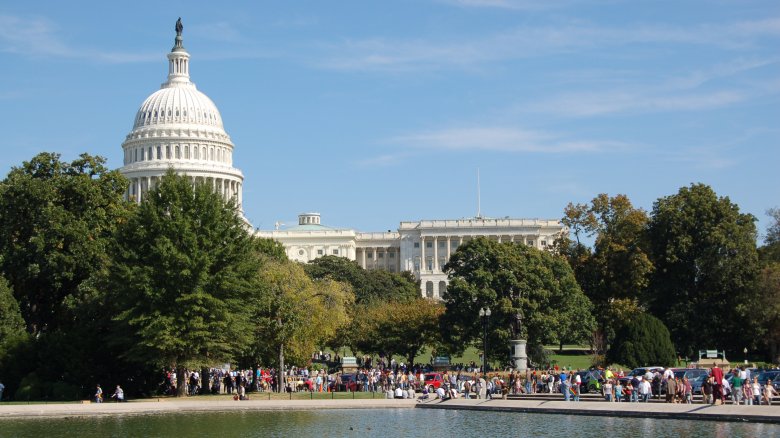The Untold Truth Of New York Bagels
Bagels are as much a part of New York as the Empire State Building, Broadway theater and (maybe) alligators. What you might consider to be a largely innocuous foodstuff is practically revered in NYC, just as it is in a handful of other cities across the globe. And can you blame them? Finding the perfect bagel is like finding nirvana, and any newcomer to the Big Apple would do well to nail down a decent list of the city's best bakeries.
But what's the story behind New York's bagels? Where do they come from? What are they doing? Where are they going? You might assume there's not much to learn about them, but you'd be wrong — the truth is that the tale behind New York's bagels is almost as rich and exciting as the bagels themselves. So grab a coffee, kick back, and settle in: this, right here, is the hole story.
Birth of the bagel
According to a profile on the history of the Bagel at The Atlantic, one account posits that New York's favorite fluffy round snack can trace its roots back at least six centuries. During the 14th century, a kind of thick bread known as pretzel arrived in Poland from Germany as part of that century's migration flow. Whilst there, the pretzel slowly became the bagel — which was then known as the 'obwarzanek'. Towards the end of the 14th century, the Polish Queen Jadwiga ate obwarzanek during Lent, rather than the fancy-pants pastries she usually ate (even though it was still pretty expensive as far as bread goes). In the wake of this, the obwarzanek became increasingly popular in Poland. Another account contests this version of events, and suggests that bagels date back to 17th century Austria, where they were invented by a Viennese baker who paid tribute to Jan Sobieski, King of Poland, by baking a bread in the shape of a horse stirrup — which, in Austrian, is called a 'beugel'.
Whichever version is correct, the bagel went on to become intrinsically linked with the Jewish religion in Poland, which, being one of the most tolerant countries in Europe, was one of the few places in the world where Jews were allowed to bake and sell bread. Over the ensuing centuries, bagels gradually became a kind of street food that was readily available for the poor.
Despite its lofty beginnings, by the latter half of this millennium the bagel had, in Eastern Europe, become the food of the common people.
Coming to America
It's generally believed that bagels arrived in New York with the Eastern European Jewish immigrants who came to the city during the late 19th century. Gradually, those immigrants spread to other parts of the city and took the bagel with them. By 1900, 70 bakeries existed across the Lower East Side, and seven years later the International Beigel Baker's Union was formed.
Thanks to advances in packaging and distribution which were made during the '60s, the bagel exploded into popularity — and, by the '80s, it had grown in size to become the classic New York bagel. New York being the melting pot city that it is, many of the city's bakeries today aren't actually Jewish-owned. H&H Bagels, for example, was set up by a Puerto Rican family, while John Marx is run by a Cincinnatian who traces his roots back to Germany. Despite this, some of the city's most renowned bakeries (such as Russ & Daughters and Zabar's) come from the same Jewish and Eastern European origins from which the bagel itself also sprang.
It's not in the water
Practically everyone who knows the New York bagel knows this one. New York bagels, the theory goes, are so good — far better than they are anywhere else, in fact — because there's something in the water that makes them that way. Unfortunately, this urban myth is exactly that: a myth. America's Test Kitchen put the New York bagel through a series of tests to determine the veracity behind the whole it's-in-the-water theory, and found that a blind taste test between bagels made with Brooklyn water and Massachusetts water came up with no difference whatsoever.
A lab analysis revealed that New York water did have a different pH level and lower amounts of calcium carbonate and magnesium than other cities, but also tested the pH levels in the finished bagels they baked, and found a minuscule difference between those made in New York and those that weren't. So while New York bagels might (might) be the best in the world, the reasoning is definitely not down to the water.
How they're made
So what does it all come down to? In a word: technique. According to Vogue, the art of making a New York bagel comes down to "a ridiculously hard blend of art and science, a feat of culinary engineering and passion that takes years of study and months of trial and error." Many bagel bakers will be unwilling to reveal all of their secrets, but one commonly-known aspect of the process involves cold-fermenting the dough. During this process, dough is left in the refrigerator for a number of days before being rolled into bagels. The longer you leave the dough in fermentation, the tangier and crustier it gets, while keeping it short results in a far lighter taste. The trick is finding the sweet spot.
Matthew Tilden of New York's Scratch Bread bakery told Vogue that "When you retard the dough, you're just slowing everything down in a colder environment. What yeast thrives off of is lots of sugar and warmth. If you give them a different environment, they can only eat slower and yeast, typically, just really slows down in the cold. We're slowing the process to develop better flavors, better crust, all that stuff." After coming out of the refrigerator, the dough is rolled into bagels, boiled in salt water, and baked in an oven. And that's how you do it.
Cream (cheese) of the crop
As you might expect, finding the best bagel in New York is one hell of a challenge. Almost every foodie site out there has got its own list of the hottest spots the city has to offer, and it stands to reason that the bakeries which show up the most are probably the places you want to be. So who, exactly, makes the cut?
Absolute Bagels is a strong contender. Situated on the Upper West Side, this bagelry might frequently have lines that extend down the street and, according to Delish, has some typically New York-ian (that is, terrible) service, but the bagels themselves (which come with such toppings as cream cheese, Tofutti, smoked fish and salads), make it more than worth the effort. "Large, crusty bagels with pillowy insides" are the order of the day at Ess-a-Bagel, according to Time Out. This Midtown bakery was launched in 1976, offers 18 varieties of homemade cream cheese and, according to Grub Street, is counted as one of Manhattan's "most venerated shops." Finally, you've got Murray's. Don't fear the long lines — Greenwich Village's favorite bakery makes bagels which are thinner and denser than those of its rivals, and provides a smorgasbord's worth of meat-filled toppings, as well as the cream cheese and fish you ought to be expecting.
Give one of those a try (or all of them) — or go somewhere else; it's not like the city is short on bakeries. There's bound to be one out there just for you.
National Bagel Day
Seems like pretty much everything's got its own celebratory day nowadays, and bagels are no different. Aficionados will be glad to hear that February 9 is National Bagel Day in the U.S. One might imagine that, on this day, bagels rain down from the heavens, cream cheese fills the sewers, and the MetLife Building becomes the BagelLife Building. Sadly, however, this is not the case. But many of New York's bakeries do host some pretty fabulous deals for anyone wanting to get their bagel on.
So what you be in store for if you happen to be in The Big Apple on this miraculous day? For National Bagel Day in 2019, Bantam Bagels offered 20 percent off using an online code plus a free six-pack of bagels at their Bleecker Street store. Meanwhile, Noah's N.Y. Bagels gave out a free bagel and shmear with purchases at their locations. Einstein Bros., one of the larger chains that extends outside of New York, tried to compete with the local big dogs and also gave away a free bagel and shmear with a purchase. So sure, maybe there's no such thing as a free lunch — but there's definitely such a thing as a slightly-cheaper-than-usual bagel. Go figure.
Breaking records
"Okay," we hear you say, "so I know where bagels come from. I know why New York does them so well. And I know where to get the cream of the crop. But, come on, answer the real question — what's the biggest bagel anyone's ever made?"
We've got your back. In 2018, a Brooklyn establishment called Acme Smoked Fish attempted to break the world record for the largest bagel and lox sandwich ever made. With the help of Zucker's Bagels, they ended up making a 213-pound 75-ounce sandwich, which was topped with around 40 pounds of Nova Scotia smoked salmon, cream cheese, tomatoes, capers, and onions. After being created, baked and recorded, the bagel was divided up and given out to the general public for free. And while it seems likely that this attempt set a record for the largest bagel and lox sandwich ever made (because nobody had ever tried to set that record before), it certainly isn't the largest bagel ever made. That honor goes to Brueggers Bagels, who in 2004 made a bagel which weighed 868 pounds for the New York state fair.
The everything bagel
The everything bagel is exactly what it sounds like: a bagel that includes a very, very large number of toppings, which generally tend to include poppy seeds, black sesame, salt, caraway seeds, sesame seeds, onion and garlic. It's an immensely popular recipe that has spawned a number of copycats, on everything from roti to croissants to fusilli pasta. And yes, naturally, the everything bagel was invented in New York.
A Long Island businessman named David Gussin claims to have invented the dish. Apparently, Gussin took a part-time job at a takeout bagelry in Howard Beach as a teenager, at which he had to sweep up burnt seeds that had fallen of while they were in the oven. Gussin, somehow, acquired quite the taste for these seeds, and one afternoon around 1980 he told his boss that they should be used as a topping on bagels. Within a year, the everything bagel — which featured all the seeds the bakery used (but not literally the ones that been on the bottom of the oven, you understand) had exploded in popularity.
Gussin himself went on to attend college, work at a number of establishments, and begin his own advertising company. Speaking to the New Yorker, he explained, "The everything bagel is my most popular creation, but it's not my most important one." His most important one would be an anti-racism slogan once used in Brooklyn schools.
The Nixon scandal
Being one of the world's bagel heartlands, New York is naturally home to some of the weirder toppings in the baking world. And nobody will be more aware of this than Cynthia Nixon, the actor-turned-politician who attracted the ire of bagel-lovers everywhere during her campaign for election as the Governor of New York.
While touring the city in late 2018, Nixon visited Zabar's, one of New York's most famous bakeries. There, she ordered the Nova (which is topped with cream cheese, smoked salmon, capers and onions; nothing too weird, there) — and she wanted it on a cinnamon raisin bagel. That latter choice was what sent ripples through the bagel community. Beset on all sides by controversy, Nixon ended up telling The New York Times, "I'm stunned. This is my bagel of choice for a few decades now. It's never been public knowledge, and I really am fascinated that people are so emotional about it."
The up-and-comer
If you actually are a New Yorker, you'll probably want to look away now. Yes, NYC has been the de facto home of bagels in the U.S. for decades now, but the truth is that it's facing a new rival for that title: Washington D.C.
According to The Washington Post, D.C.'s bagels aren't simply copies of their New York cousins — while many of them borrow from the recipes of New York (and Montreal, the other bagel Mecca in North America), each of the city's bakeries offer what one founder describes as "its own new breed." Many of the toppings will be familiar, including salmon and whitefish, but there are a few innovations on display as well: asiago, bacon peanut butter, peach jam, bacon, potato chips and jalapeño have all ended up on the menu.
The Post also ran a taste test to decide which of the city's two most beloved bakeries comes out on top, and found that Call Your Mother, a Georgia Avenue establishment that began by baking pizza, won out. Now, we wouldn't dare suggest that any New Yorkers attempt to smuggle a D.C. bagel back home (you'd probably end up excommunicated), but it's got to be worth a try next time you're passing through.
New York's nemesis
If Washington D.C. is the scrappy newcomer on America's bagel scene, Montreal is New York's nemesis. According to The Takeout, the two cities' bagels are vastly different from one another — New York bagels are "bigger, more pliable [...] and salty." Montreal bagels, on the other hand, are "sweeter [...] smaller, and crispier, with a chewy interior." Crucially, Montreal bagels are still cooked in wood-burning ovens, while their New York counterparts are often baked with gas and electric ovens.
In Montreal, bagels are even counted as a kind of "social currency," and are frequently used as gifts at housewarming parties, wakes and other such social events. The people of Montreal tend to eat their bagels with sesame or poppy seeds, toasted and with cream cheese and smoked salmon. The city itself is also home to its own inter-bakery feud, unlike anything you'd find in New York. St-Viateur Bagel and Fairmount Bagel, both located in the city's Mile End area, each inspire their own allegiances among Montreal's residents, many of which are passed down from generation to generation — and siding with one can earn you the eternal derision of the other's followers. Basically, Montreal takes bagels really seriously.
Bagels gone global
Of course, North America isn't the home of the bagel, nor is it the only place you'll find them — not by a long shot. Today, bagels of some kind or another are enjoyed practically everywhere on Earth. Take China, for example, which is home to Girde nan, a type of bread eaten in Xinjiang which is baked in a tandoori oven. Finland has the vesirinkeli, which is boiled in water before baking, and tends to come toasted and buttered by default. Jerusalem bagels are oblong and frequently topped with sesame seeds, while Japan is home to the green tea bagel, which is pretty much exactly what it sounds like.
Move over to Russian you'll find sushki, a sweet and crunchy bagel off-shoot which is smaller than most and rarely features toppings. Turkish bagels are crispy and usually drunk with tea, and bubliks, a dense and chewy kind of bagel which often comes with grated cheese and onion juice, are found all across Eastern Europe, in Ukraine, Russia, Belarus, Poland and Lithuania. Put simply — no matter where you are in the world, if there's bread, there are bagels. And we wouldn't have it any other way.
